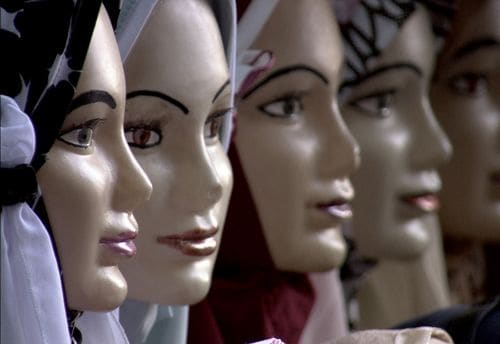Eye For Film >> Movies >> The Tainted Veil (2015) Film Review
The Tainted Veil
Reviewed by: Jennie Kermode

Although it has been around for some 4,000 years, the veil is today primarily associated, at least in Western minds, with Islam. This a curious development, since no part of the Qur'an mandates its wearing, yet its visibility has made it a key cultural symbol - and, alas, led to veiled women being easy targets for expressions of Islamophobia. As debates rage across Europe about whether or not it should be banned, this documentary interviews people around the world about their views - academics, religious figures and, most importantly, Mulim women themselves.
Unless you've been following these debates closely, you may not have realised how rare it is for women's voices to be heard - and to be heard in diversity, making arguments for and against or simply stating that they don't see what all the fuss is about. To some, it's just a piece of clothing, something that might be fashionable or comfortable. For others, it conveys a sense of security through its familiarity and provision off personal space. Some feel safer from leering men whilst others warn of the risk of attracting other kinds of unwanted attention. In the West, some fear that it makes them stand out to much, whilst in predominantly Muslim countries women worry that not wearing it would have the opposite effect. One woman talks about giving it up because she wanted to feel youthful and enjoy her beauty. Several say that whether or not it's worn is less important than the reasons for that decision - if it's about wanting to be closer to God, that's wonderful, but if it's due to coercion then, spiritually, what's the point?
For many Westerners, this broad range of opinions will come as a surprise; we're so used to reductive statements which imply that all Muslims think the same way or present the religion itself as monolithic, in ignorance of its multiple sects and modes of practice. It certainly makes a change from hearing men talk about liberating women by telling them what to wear. some off the women are living in countries where the veil has been banned in certain contexts, and they talk about the impact this has had on their lives, in many cases making them feel forced to give up their employment or retreat from society. The film touches only lightly on those places where veiling is obligatory; it is enough simply to remind us, because most of us will have heard expressions of dissent from those women before.
One of the reasons why women's voices are heard so rarely on this topic, a Damascene scholar suggests, is that it isn't really about women; this is a conflict of civilisations being playing out with their bodies as the battleground, a struggle between religious and nonreligious worlds. Unfortunately his term for 'nonreligious' is translated as 'secular', which in context serves to perpetuate a popular misunderstanding of the nature of secularism (identifying it as anti-religious), ironic in light of the fact that another speaker here champions Islam's own tradition of respect for all faiths and several talk about finding their own religious paths. It's one of a number of small shifts in language which have something of their own to say about how conflicts develop.
After a first half which concentrates on opinion, the second half goes into more depth and provides a potted history of the veil. There are a couple of odd arguments made here, such as the suggestion that most women wore veils historically (Australasia, the Americas and large portions of East Asia might beg to differ), but important points are made about the cultural rather than religious origins of the garment and about its use for protecting sacred objects before it was extended to women. This creates space to introduce two other important ideas: the veil as something that creates equality by ensuring women are noticed not for their bodies bu for their minds; and the veil as something which labels women as responsible for the action of men who find them attractive. Overall, the film does a good job of balancing each case, with what might seem like a biased title concealing something more interesting.
The other success of this film is in highlighting the work of a number of highly capable and influential Muslim women who don't always get the attention they deserve. Whether or not they are hijabi, Muslim girls watching this film will go away feeling empowered by the presence of so many strong role models. It's sad, of course, that this is needed, but ultimately it's not just the veil that keeps such women out of sight.
Reviewed on: 01 Oct 2015
















